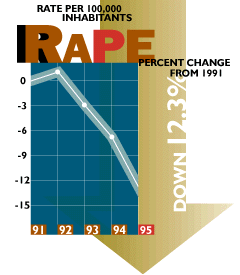

The three also dismiss more conservative theories. Some commentators say expanding the death penalty and passing the "three-strikes-you're-out" law for repeat felons have had a chilling effect. The NRA, for example, credits the widespread sale of handguns, arguing that having guns in the home has scared criminals away from unlawful activity.
Bridges scoffs at the claims. "Do people actually contemplate the likelihood of arrest in the act of domestic violence or robbery?" asks Bridges. Most research shows that they don't, he adds.
Bridges also says research at Florida State University--some of it financed by the NRA--shows "the availability of guns increases the lethality of violence. People who used to be stabbed or assaulted are now shot." Juvenile crime, one of Bridges' specialties, may have become more lethal now due to the proliferation of guns.
Comparing states with high gun ownership with those with lower rates also counters the NRA's argument. "There are too many places where guns are not widely held where the crime rates are much lower," says Weis.
Looking at "three-strikes" provisions, Crutchfield compares Washington to Oregon, which doesn't have this law. Both have experienced the same drop in crime rates, he notes.
The death penalty also has little effect, Crutchfield says. He compares Illinois to Michigan--similar Midwestern industrial states, one with the death penalty and one without. Both have experienced similar drops in crime over the last five years.
 But with the prison
population doubling since 1985 and the crime rate dropping over the last five
years--isn't there some kind of correlation? "It just doesn't begin to wash,"
counters Crutchfield. "Most of the expansion has been for drug violations. Yet
the crime rate has fallen in other areas."
But with the prison
population doubling since 1985 and the crime rate dropping over the last five
years--isn't there some kind of correlation? "It just doesn't begin to wash,"
counters Crutchfield. "Most of the expansion has been for drug violations. Yet
the crime rate has fallen in other areas."
Bridges is slightly less skeptical. "There might be a correlation but it's not a strong one," he says. He notes that while in the 1990s, about 75 percent of the Washington state prison population is incarcerated for violent crimes, the property crime rate has gone down just as fast as the violent crime rate.
Historically the correlation just isn't there, Bridges feels. "If you go back 50 years and look at prison population rates, you will see that they can go up at the same time the crime rate goes up," he says.
Stopping crime at its source may be one answer, say the threesome. Some community-based prevention programs are helping combat crime, while other efforts are not very effective. "It's hard to attribute the success at the national level, but there is long-term promise for some community-based programs, if they are funded adequately," says Bridges. Neighborhood block watch groups, adds Weis, seem to be effective against property crime.
A study by the RAND Corp. compared the effectiveness of different prevention programs. "They found that the biggest impact, in terms of reducing the risk of committing crimes, was paying kids to finish high school," Bridges says.
"The most basic prevention programs keep kids involved with their school," adds Crutchfield. "What we need to do is support families and improve schools." Weis is impressed with programs that seek out "dysfunctional families" before the children turn to crime, "programs that work within the community with families that need help," he says.
The professors have little good to say about some visible prevention programs such as D.A.R.E. or midnight basketball at community centers. "A number of studies have shown that D.A.R.E. has had no effect on drug use," says Crutchfield. "The same with gang intervention programs."
As for midnight basketball, he scoffs, "Crime takes five minutes. There might be good reasons to do it for the community, but not for crime control."
It's the Economy, Stupid--Isn't it?
Send a letter to the editor at columns@u.washington.edu.